Shark Hunter

 The Game: In the Arctic Circle, there are two certainties: not eating will kill you, and being in the water too long will kill you. You have to brave both possibilities in this game, trying to keep the fishing nets intact, and trying to fend off the roaming sharks intent on biting through the nets. There are both stationary and moving ice floes, and you can jump from one to the other (or to the shore), with your spear at the ready to impale a shark – but sooner or later you also have to jump into the freezing water to repair the nets, leaving you at the sharks’ mercy. (GST Video, 1984 / released by Classic Console Center in 2006)
The Game: In the Arctic Circle, there are two certainties: not eating will kill you, and being in the water too long will kill you. You have to brave both possibilities in this game, trying to keep the fishing nets intact, and trying to fend off the roaming sharks intent on biting through the nets. There are both stationary and moving ice floes, and you can jump from one to the other (or to the shore), with your spear at the ready to impale a shark – but sooner or later you also have to jump into the freezing water to repair the nets, leaving you at the sharks’ mercy. (GST Video, 1984 / released by Classic Console Center in 2006)
Memories: This unreleased gem from the Odyssey2/Videopac library is a fine specimen of the best Odyssey2 games – offbeat, original (or at least adding original twists to popular themes) and unique. Shark Hunter was designed for the European market, but was never released in this form when the crash of the video game industry caught up with overseas game makers. (A version of it later appeared for MSX computers overseas.) It’s fun and frustrating, and would’ve been a more than welcome addition to the Odyssey2 or Videopac libraries.
River Raid
 The Game: You’re piloting a fighter jet on a canyon run through enemy territory. You can’t fly outside the canyon walls, so stay over the river and blast everything in sight. Well, almost everything – flying your plane on top of “FUEL” buoys instead of shooting them puts a little bit of gas in the tank, and if you run out of fuel, you might as well just swallow the next enemy bullet, because you’re goin’ down. (Activision, 1984)
The Game: You’re piloting a fighter jet on a canyon run through enemy territory. You can’t fly outside the canyon walls, so stay over the river and blast everything in sight. Well, almost everything – flying your plane on top of “FUEL” buoys instead of shooting them puts a little bit of gas in the tank, and if you run out of fuel, you might as well just swallow the next enemy bullet, because you’re goin’ down. (Activision, 1984)
Memories: A dandy upgrade from the Atari 2600 River Raid, the Colecovision edition plays much the same. There are some audiovisual improvements, but it’s also surprising to see what’s been left alone in the graphics department too: these elements of the game weren’t broken, so there are no “fixes” for their own sake.
Q*Bert’s Qubes
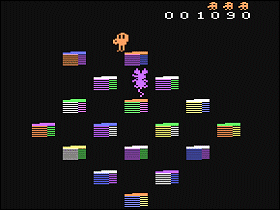 The Game: Q*Bert is back, hopping around from cube to cube, rotating the cubes 90 degrees with every hop…but a nasty bouncing rat and his minions are out to get the big Q. If one of the rat’s henchmen hops onto a cube whose top surface is the same color as its skin, it melts into the cube harmlessly. Q*Bert must change at See the videoleast one row of cubes to the target color to advance to the next level – and there aren’t any flying discs this time! (Parker Brothers, 1984)
The Game: Q*Bert is back, hopping around from cube to cube, rotating the cubes 90 degrees with every hop…but a nasty bouncing rat and his minions are out to get the big Q. If one of the rat’s henchmen hops onto a cube whose top surface is the same color as its skin, it melts into the cube harmlessly. Q*Bert must change at See the videoleast one row of cubes to the target color to advance to the next level – and there aren’t any flying discs this time! (Parker Brothers, 1984)
Memories: Thanks to a quirk of distribution more than anything, Q*Bert’s Qubes is one of the rarest and most valuable games for the Atari 2600. In the post-crash world of unhealable deep-cut discounts, some retailers decided to get out of the video game “fad” as soon as they could possibly get out from under the inventory. As a result, the final few Parker Brothers game cartridges wound up being sold almost exclusively through Sears. (As the retail chain that invested heavily in such products as Atari’s original home Pong console, Sears had more of a stomach for staying with the video game industry than most, but even then they balked a bit as the Atari gravy train went off the rails.)
Pitstop
 The Game: A day at the races is just another day at the office for you. Pick from a variety of tracks and difficulty levels and try to achieve maximum speed…with a minimum of collisions. (Epyx, 1984)
The Game: A day at the races is just another day at the office for you. Pick from a variety of tracks and difficulty levels and try to achieve maximum speed…with a minimum of collisions. (Epyx, 1984)
Memories: Not quite as pretty as Turbo, Pitstop is a port of a game that Epyx had already made popular on the Atari home computers and the Commodore 64. Though the crash was in full swing by now, Epyx seemed to be hedging its bets by producing console games for the Colecovision and the Atari 2600. But graphically, and in terms of smooth game play, Turbo wins the race ahead of Pitstop in just about every area – and it’s all about control.
Pitfall II: Lost Caverns
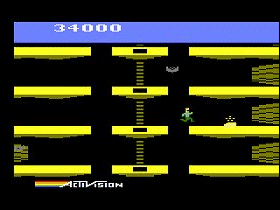
 The Game: As famed treasure-hunter Pitfall Harry, you’re delving deep into the Lost Caverns, which are loaded with Incan treasures beyond compare – or so they say. But the vast subterranean chambers are also full of dangers – bats, poisonous frogs, electric eels, and huge chasms. Touching any one of these creatures will force you to retreat to the last base camp you established, and you’ll lose points every second until you get back there. The only way to win the game is to find your way back to the surface after recovering all of the treasures of the Lost Caverns – and to do this, you won’t be able to go back the way you came. (Activision, 1984)
The Game: As famed treasure-hunter Pitfall Harry, you’re delving deep into the Lost Caverns, which are loaded with Incan treasures beyond compare – or so they say. But the vast subterranean chambers are also full of dangers – bats, poisonous frogs, electric eels, and huge chasms. Touching any one of these creatures will force you to retreat to the last base camp you established, and you’ll lose points every second until you get back there. The only way to win the game is to find your way back to the surface after recovering all of the treasures of the Lost Caverns – and to do this, you won’t be able to go back the way you came. (Activision, 1984)
Memories: This was the best game ever created for the Atari 2600, hands-down.
Jr. Pac-Man
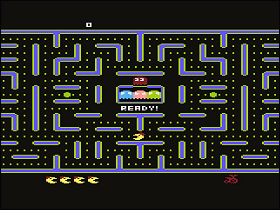
 The Game: As the offspring of a round yellow creature consisting of a mouth and nothing else, you maneuver around a bigger maze than your parents ever had to deal with, gobbling small dots and evading four colorful monsters who can eat you on contact. Six large flashing dots in the maze enable you to turn the tables and eat the monsters for a brief period. Periodically, assorted toys will begin hopping through the maze, turning every uneaten dot they touch into a larger dot which yields more points, but also forces little Pac to slow down to digest them. The monsters, once eaten, return to their home base in ghost form and return to chase you anew. If cleared of dots, the maze refills and the game starts again, but just a little bit faster… (Atari, 1984; released by AtariAge.com, 2003)
The Game: As the offspring of a round yellow creature consisting of a mouth and nothing else, you maneuver around a bigger maze than your parents ever had to deal with, gobbling small dots and evading four colorful monsters who can eat you on contact. Six large flashing dots in the maze enable you to turn the tables and eat the monsters for a brief period. Periodically, assorted toys will begin hopping through the maze, turning every uneaten dot they touch into a larger dot which yields more points, but also forces little Pac to slow down to digest them. The monsters, once eaten, return to their home base in ghost form and return to chase you anew. If cleared of dots, the maze refills and the game starts again, but just a little bit faster… (Atari, 1984; released by AtariAge.com, 2003)
Memories: A victim of former Commodore executive Jack Tramiel’s takeover of Atari‘s home video game and computer division, Jr. Pac-Man was one of the many “orphaned” games that were finished and ready for mass-production, but despite the money that had been spent on acquiring the license and developing the actual software, Jr. Pac-Man stayed off the schedule, never to hit the stores.
Moto-Crash+
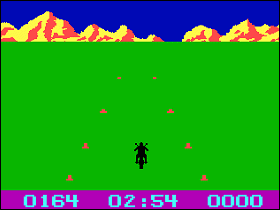 The Game: It’s a cross-country motorcycle race, and you’re at the handlebars. Avoid other bikes, stay within the traffic markers, and be alert to constantly changing lighting conditions and weather (this race is 24 hours a day, and the days seem awfully short). (Philips, 1984)
The Game: It’s a cross-country motorcycle race, and you’re at the handlebars. Avoid other bikes, stay within the traffic markers, and be alert to constantly changing lighting conditions and weather (this race is 24 hours a day, and the days seem awfully short). (Philips, 1984)
Memories: Released only in Europe (and, for the most part, confined to France, where it was sold for the Jopac+ console, the Gallic equivalent to the Videopac G7400 or the Odyssey3), Moto-Crash+ is a fairly bold attempt to do something that was unheard of on the original Odyssey2/Jopac hardware: a first-person racing game along the lines of Enduro.
It’s Only Rock ‘N’ Roll
 The Game: You control the destiny of a pixellated rock band. A menu presents you with options to write songs, play concerts, go on tour, or even sign witha record company if you’ve racked up the money and the popularity (and the band still has the energy and drive to work a crowd). You can ask your manager to try to work out some special deals for you, but even success has its dark side – and what’s worse, now the dark side of stardom is randomly generated! (Xonox / K-Tel, 1984)
The Game: You control the destiny of a pixellated rock band. A menu presents you with options to write songs, play concerts, go on tour, or even sign witha record company if you’ve racked up the money and the popularity (and the band still has the energy and drive to work a crowd). You can ask your manager to try to work out some special deals for you, but even success has its dark side – and what’s worse, now the dark side of stardom is randomly generated! (Xonox / K-Tel, 1984)
Memories: This game isn’t Dark Side Of The Moon or Sgt. Pepper. This game isn’t even up to Dr. Demento standards. This game isn’t even “Achy Breaky Heart” and it’s not even the Macarena. Because at least those flash-in-the-pan hits were catchy and compelling on some level, and people came back to them again and again for a feel-good fix. I can’t say the same for It’s Only Rock ‘N’ Roll for the Colecovision.
H.E.R.O.
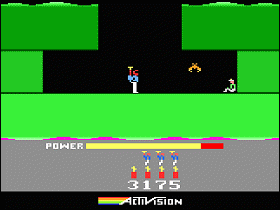
 The Game: As an airborne rescuer with a helicopter backpack and plenty of explosives, your job is to fly (and run) through a series of sinister caverns, retrieving hostages and doing away with such deadly dangers as poisonous spiders. (In short, you’re venturing into places that would have Pitfall Harry making a tar pit in his pants.) Oh, and make sure you don’t shoot out the lights handily installed in nearly every cavern, or you won’t be able to see the danger until you put your foot in it – and then even your helicopter backpack won’t help you. (Activision, 1984)
The Game: As an airborne rescuer with a helicopter backpack and plenty of explosives, your job is to fly (and run) through a series of sinister caverns, retrieving hostages and doing away with such deadly dangers as poisonous spiders. (In short, you’re venturing into places that would have Pitfall Harry making a tar pit in his pants.) Oh, and make sure you don’t shoot out the lights handily installed in nearly every cavern, or you won’t be able to see the danger until you put your foot in it – and then even your helicopter backpack won’t help you. (Activision, 1984)
Memories: One of Activision’s most celebrated originals, H.E.R.O. is a fast-paced game with enough exploration and enough hair-trigger excitement to keep all kinds of gamers happy. In some respects it’s very similar to Pitfall II, only this time you get to blow obstacles away instead of just having to avoid them.
Gyruss
 The Game: The aliens are taking their complaints to the home office! As the pilot of an agile space fighter, you have to blast your way through the alien forces from Pluto all the way back to Earth. Occasionally you can boost your ship’s firepower, but that’s the only help you’re going to get. The rest is up to your speed, your strategy, and your ability to nail those suckers in mid-dive. (Parker Brothers, 1984)
The Game: The aliens are taking their complaints to the home office! As the pilot of an agile space fighter, you have to blast your way through the alien forces from Pluto all the way back to Earth. Occasionally you can boost your ship’s firepower, but that’s the only help you’re going to get. The rest is up to your speed, your strategy, and your ability to nail those suckers in mid-dive. (Parker Brothers, 1984)
Memories: A valiant attempt by Parker Bros. to translate Konami’s smash hit shooter to the 2600, Gyruss wins points for effort and attention to detail, but still manages to lose something in the translation.
Ghostbusters
 The Game: The only video game in history that turns you into Bill Murray, Ghostbusters gives you a taste of the lucrative franchising opportunity that is supernatural paranormal investigation and elimination. You start the game out with a supply screen and – naturally – a limited budget. Pick up all the ghostbusting gear you can afford and get to work. Much of the game is played out on a map of several city blocks of the Big Apple, where haunted buildings will flash red. You respond to each call by going there, which takes you to a brief “driving” game in which you can vacuum up free-roaming ghosts (if you’ve installed a ghost-vac on your car). Once you arrive, set the trap and position your two busters carefully (so as not to cross the streams), and snag the ghost before it simply leaves or slimes you. Trapping ghosts will net the big bucks, which you need to continue your franchise. Letting the paranormal activity in New Your City continue unabated will result in the unleashing of the Sta-Puft Marshmallow Man, who’ll stomp entire city blocks (and earn you a hefty fine). If the city’s PK (psychokinetic) activity meter reaches 10,000, the game is over. (Activision, 1984)
The Game: The only video game in history that turns you into Bill Murray, Ghostbusters gives you a taste of the lucrative franchising opportunity that is supernatural paranormal investigation and elimination. You start the game out with a supply screen and – naturally – a limited budget. Pick up all the ghostbusting gear you can afford and get to work. Much of the game is played out on a map of several city blocks of the Big Apple, where haunted buildings will flash red. You respond to each call by going there, which takes you to a brief “driving” game in which you can vacuum up free-roaming ghosts (if you’ve installed a ghost-vac on your car). Once you arrive, set the trap and position your two busters carefully (so as not to cross the streams), and snag the ghost before it simply leaves or slimes you. Trapping ghosts will net the big bucks, which you need to continue your franchise. Letting the paranormal activity in New Your City continue unabated will result in the unleashing of the Sta-Puft Marshmallow Man, who’ll stomp entire city blocks (and earn you a hefty fine). If the city’s PK (psychokinetic) activity meter reaches 10,000, the game is over. (Activision, 1984)
Memories: An addictive little game, this, and probably one of the best movie-to-video-game licenses ever brought to life. Ghostbusters on the big screen was big money when this game was released, and Activision had to deliver a decent game.
Frenzy
 The Game: You’re back in the maze, but this time, the stakes are increased, the danger is increased, and your strategic options are only slightly increased. Touching the walls, the robots, the robots’ laser blasts, or even your own ricocheted lasers are deadly. And of course, the inevitable appearance by Evil Otto is also deadly. However, you can temporarily repel the smiley little bugger by blasting him until his grin turns into the frown – but he will reappear mere seconds later, moving much faster every time he must retreat and reappear – so you’re not doing yourself any favors. If you enter a generator room, you can halt all the robots in their tracks by penetrating the walls surrounding the generator and blasting it. “Beaded” walls can be eaten away, bit by bit, by laser fire from anyone who shoots it, while solid walls will ricochet lasers around until they hit something – which could mean a death trap for you. (Coleco, 1984)
The Game: You’re back in the maze, but this time, the stakes are increased, the danger is increased, and your strategic options are only slightly increased. Touching the walls, the robots, the robots’ laser blasts, or even your own ricocheted lasers are deadly. And of course, the inevitable appearance by Evil Otto is also deadly. However, you can temporarily repel the smiley little bugger by blasting him until his grin turns into the frown – but he will reappear mere seconds later, moving much faster every time he must retreat and reappear – so you’re not doing yourself any favors. If you enter a generator room, you can halt all the robots in their tracks by penetrating the walls surrounding the generator and blasting it. “Beaded” walls can be eaten away, bit by bit, by laser fire from anyone who shoots it, while solid walls will ricochet lasers around until they hit something – which could mean a death trap for you. (Coleco, 1984)
Memories: It’s a bit of a rarity for an arcade manufacturer to license a sequel game to a different company than licensed the original, yet it happened in a handful of cases. Atari had licensed the arcade hit Berzerk and turned it into a near-perfect cartridge for the VCS, but when it came time to license the diabolically difficult follow-up for home video game play, it was Coleco who nabbed the rights.
Front Line
 The Game: You’re a lone footsoldier fighting your way through a platoon of enemy troops, trying to take out as many of them as you can until you find your way to a handy empty tank. But once you man your own tank, enemy tanks surround you. If one of them hits your tank, you have mere seconds to bail out before your tank blows, and you have to dodge cannon fire until you can find another friendly tank to commandeer. After crossing hazardous stretches of desert and fighting off entire battallions of enemy tanks, you’re en route to the final confrontation, a showdown with the enemy’s armored headquarters… (Coleco, 1984)
The Game: You’re a lone footsoldier fighting your way through a platoon of enemy troops, trying to take out as many of them as you can until you find your way to a handy empty tank. But once you man your own tank, enemy tanks surround you. If one of them hits your tank, you have mere seconds to bail out before your tank blows, and you have to dodge cannon fire until you can find another friendly tank to commandeer. After crossing hazardous stretches of desert and fighting off entire battallions of enemy tanks, you’re en route to the final confrontation, a showdown with the enemy’s armored headquarters… (Coleco, 1984)
Memories: At one time, this was one of my all-time favorite Atari 2600 games – well, it still is, actually – even though it really pales in comparison to the coin-op it’s based on. Even the version released for the ColecoVision, which used the roller wheel on the Super Action Controller to stand in for the arcade game’s aiming knob, wasn’t quite the same. Still, at the time, this did just fine: you fired your gun in whatever direction you were facing.
Dragonfire
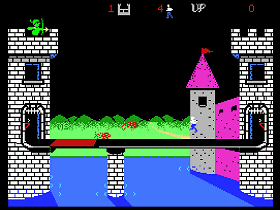 The Game: You’re another treasure-hunting glory seeker who’s about to meet more than his match. If you can survive crossing the drawbridge into the castle – a task made incredibly difficult by the glowing fireballs of dragon breath being hurled toward you – you’ve got an even more hazardous obstacle ahead: the dragon himself is guarding a huge stash of treasure. Even if he can’t stop you from pocketing every shiny thing in the castle, chances are you won’t make it out alive. (Imagic, 1984)
The Game: You’re another treasure-hunting glory seeker who’s about to meet more than his match. If you can survive crossing the drawbridge into the castle – a task made incredibly difficult by the glowing fireballs of dragon breath being hurled toward you – you’ve got an even more hazardous obstacle ahead: the dragon himself is guarding a huge stash of treasure. Even if he can’t stop you from pocketing every shiny thing in the castle, chances are you won’t make it out alive. (Imagic, 1984)
Memories: A nicely dolled-up version of a game that was already a lot of fun on the Atari 2600 and Intellivision, Dragonfire is one of Imagic‘s few Colecovision entries. The game is still fun, but now it looks simply incredible too.
Dig Dug
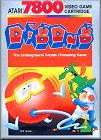 The Game: Who said landscaping was easy? You are Dig Dug, an intrepid gardener whose soil is infested with pesky Pookas and fire-breathing Fygars. You’re armed with your trusty pump, which you can use to inflate your enemies until, finally, they blow up. But both the Pookas and Fygars can crawl through the ground and can pop out into your tunnels, and if a Fygar sneaks up behind you, he can toast you if you’re not careful. (Atari, 1984)
The Game: Who said landscaping was easy? You are Dig Dug, an intrepid gardener whose soil is infested with pesky Pookas and fire-breathing Fygars. You’re armed with your trusty pump, which you can use to inflate your enemies until, finally, they blow up. But both the Pookas and Fygars can crawl through the ground and can pop out into your tunnels, and if a Fygar sneaks up behind you, he can toast you if you’re not careful. (Atari, 1984)
Memories: Still clinging tenaciously to a licensing agreement that gave it the right to publish Dig Dug in the U.S., Atari dug in its heels and released Dig Dug for the Atari 7800. Fortunately – for Atari, that is – Namco opted not to issue the same game in that territory, leaving it an exclusive for owners of the Famicom, Japan’s equivalent to the NES.
Defender II / Stargate
 The Game: Once again, you’re piloting a sleek spacecraft, patrolling the airspace over a populated planet whose inhabitants are being harvested by alien Landers to create berzerker Mutants. If you shoot down a Lander in mid-air and its abductee falls toward the ground, you must catch the helpless kidnap victim and lower him to the ground safely. Other menaces await you in the sky, along with Stargates, which instantaneously transport you to other locations around the planet. (Atari, 1984)
The Game: Once again, you’re piloting a sleek spacecraft, patrolling the airspace over a populated planet whose inhabitants are being harvested by alien Landers to create berzerker Mutants. If you shoot down a Lander in mid-air and its abductee falls toward the ground, you must catch the helpless kidnap victim and lower him to the ground safely. Other menaces await you in the sky, along with Stargates, which instantaneously transport you to other locations around the planet. (Atari, 1984)
Memories: I like to refer to this game as Defender: The Apology. In much the same way that Atari made good on gamers’ disappointment in their original Pac-Man cartridge with its Ms. Pac-Man translation, the Stargate cartridge plays much more like “real” Defender than the original cartridge version of that game. The sounds and graphics are pretty much dead-on, if not quite as fine as those of the original arcade machine.
Crystal Castles
 The Game: You are Bentley the Bear, cuddly defender of a vaguely 3-D fairy tale realm just loaded with ruby-like crystals. While this would seem like an idyllic existence for many sentient stuffed animals, it is, of course, not that easy. Berthilda the Witch has sent her evil minions to seize the crystals for her. Walking trees,
The Game: You are Bentley the Bear, cuddly defender of a vaguely 3-D fairy tale realm just loaded with ruby-like crystals. While this would seem like an idyllic existence for many sentient stuffed animals, it is, of course, not that easy. Berthilda the Witch has sent her evil minions to seize the crystals for her. Walking trees,  upright centipedes, and animated skeletons prowl the geometric vistas to keep Bentley from claiming the crystals. Finding the wizard hat will briefly give Bentley the power to dispose of Berthilda if and when she makes an appearance. Bentley also has a weakness for the pot of honey that appears on each level – and if he grabs the honey, a swarm of bees suddenly has a problem with him. Clearing each screen of crystals advances to the next level. Keep in mind that the enemies can also consume crystals, so they may actually clear the level – Bentley gets a bonus if he’s the one who nabs the last gem on the screen. (Atari, 1984)
upright centipedes, and animated skeletons prowl the geometric vistas to keep Bentley from claiming the crystals. Finding the wizard hat will briefly give Bentley the power to dispose of Berthilda if and when she makes an appearance. Bentley also has a weakness for the pot of honey that appears on each level – and if he grabs the honey, a swarm of bees suddenly has a problem with him. Clearing each screen of crystals advances to the next level. Keep in mind that the enemies can also consume crystals, so they may actually clear the level – Bentley gets a bonus if he’s the one who nabs the last gem on the screen. (Atari, 1984)
Memories: This game is a tough nut to crack. It’s something I’d file under “games I can’t believe anyone tried to port to the Atari 2600,” the same category where I’d put Coleco’s disastrous port of Zaxxon. Surprisingly though, while the graphics are a bit of a mess, enough of the game play is intact to make this version of Crystal Castles surprisingly effective.
Crazy Climber
 The Game: You control a daredevil stunt climber on his trip up the side of a building, using no ropes, no nets, and nothing but his hands and his feet. Obstacles such as a large stork with (apparently flaming) droppings can cause you to plunge to your death several stories below, and even minor things such as annoyed building tenants dropping potted plants at you from above can have the same disastrous effect. When you reach the top – if you reach the top, that is – a helicopter lifts you away to your next challenge. (Atari, 1984 – fan club exclusive)
The Game: You control a daredevil stunt climber on his trip up the side of a building, using no ropes, no nets, and nothing but his hands and his feet. Obstacles such as a large stork with (apparently flaming) droppings can cause you to plunge to your death several stories below, and even minor things such as annoyed building tenants dropping potted plants at you from above can have the same disastrous effect. When you reach the top – if you reach the top, that is – a helicopter lifts you away to your next challenge. (Atari, 1984 – fan club exclusive)
Memories: Crazy Climber for the 2600 is one of the rarest cartridges manufactured by Atari, having been released only through the company’s Atari Age fan club newsletter rather than at retail. On the basis of its scarcity alone, the Crazy Climber cartridge auctions for – appropriately – crazy amounts of money.
Congo Bongo
 The Game: Bongo the Ape sets your toes on fire while you’re asleep during a jungle expedition. So naturally, you drop everything to take revenge on the goofy gorilla. But first you have to reach him. The first level is a hazardous assortment of ramps and levels and a waterfall to jump across. Be careful of pesky little monkeys who can weigh you down so you move slower (and jump lower), and watch out for snakes. Then you have to hop across various islands and dodge more snakes as you try to get across a river. (Coleco [under license from Sega], 1984)
The Game: Bongo the Ape sets your toes on fire while you’re asleep during a jungle expedition. So naturally, you drop everything to take revenge on the goofy gorilla. But first you have to reach him. The first level is a hazardous assortment of ramps and levels and a waterfall to jump across. Be careful of pesky little monkeys who can weigh you down so you move slower (and jump lower), and watch out for snakes. Then you have to hop across various islands and dodge more snakes as you try to get across a river. (Coleco [under license from Sega], 1984)
Memories: Congo Bongo was one of those games that really tested the mettle of the next-generation consoles of the day. Sega’s own translation of the game for the Atari 2600 was a barely-playable mess, though the version released for the Atari 5200 was a marked improvement. But as with Zaxxon, its cousin from a visual-concept point of view, Congo Bongo didn’t really arrive at home until ported to the ColecoVision.
Cosmic Commuter
 The Game: Sometimes it’s not all about saving the whole freakin’ world. Sometimes it’s about just being a cabbie. Picking people up, zipping through traffic, and trying to get them to where they’re going without them – or yourself – killed in the process. Substitute traffic for alien ships and space debris, and you’ve got Cosmic
The Game: Sometimes it’s not all about saving the whole freakin’ world. Sometimes it’s about just being a cabbie. Picking people up, zipping through traffic, and trying to get them to where they’re going without them – or yourself – killed in the process. Substitute traffic for alien ships and space debris, and you’ve got Cosmic  Commuter. Make sure your taxi pod is loaded up on fuel, avoid everything except for the passengers, and don’t forget to dock safely with your launch/landing module when you’ve picked everyone up. You can shoot obstacles out of your way in a tight squeeze, but be careful – you could also shoot your next refueling station out of the sky too. Three collisions or crash landings due to an empty gas tank, and you’re out of the taxi business. (Activision, 1984)
Commuter. Make sure your taxi pod is loaded up on fuel, avoid everything except for the passengers, and don’t forget to dock safely with your launch/landing module when you’ve picked everyone up. You can shoot obstacles out of your way in a tight squeeze, but be careful – you could also shoot your next refueling station out of the sky too. Three collisions or crash landings due to an empty gas tank, and you’re out of the taxi business. (Activision, 1984)
Memories: Cosmic Commuter is a very cool scrolling game with a neat premise, something that I can identify with a lot better than being a fighter jock. This is also an extremely colorful game with a heap of animated graphics, and not one second of sprite flicker.
Buck Rogers: Planet Of Zoom
 The Game: Zoom being the operative word here, your mission – as space hero Buck Rogers – is to fly in close quarters with all kinds of enemy ships, landers and structures, fending off their attacks, and generally staying alive as long as possible. Obligatory robot wisecracks and utterances of “beedy-beedy-beedy” not included. (Coleco [under license from Sega], 1984)
The Game: Zoom being the operative word here, your mission – as space hero Buck Rogers – is to fly in close quarters with all kinds of enemy ships, landers and structures, fending off their attacks, and generally staying alive as long as possible. Obligatory robot wisecracks and utterances of “beedy-beedy-beedy” not included. (Coleco [under license from Sega], 1984)
Memories: Far and away the most faithful home console version of Sega’s arcade sleeper hit, Buck Rogers: Planet Of Zoom is a blast on the ColecoVision.
Bump ‘n’ Jump
 The Game: The race is on, and no moves are off-limits – bump your competitors off the road (and into apparently highly volatile vegetation that causes them to explode), or jump over them and any other obstacles that get in your way, including areas of water that cover the road. If you survive the race, you live on to the next round – at least until you run out of cars. (Coleco, 1984)
The Game: The race is on, and no moves are off-limits – bump your competitors off the road (and into apparently highly volatile vegetation that causes them to explode), or jump over them and any other obstacles that get in your way, including areas of water that cover the road. If you survive the race, you live on to the next round – at least until you run out of cars. (Coleco, 1984)
Memories: Another Sega arcade sleeper-hit snagged for the Colecovision under an overall contract between the two game companies, Bump ‘N’ Jump is fun on four wheels, and this console version drives it home perfectly.
Buraco Negro! (“Black Hole!”)
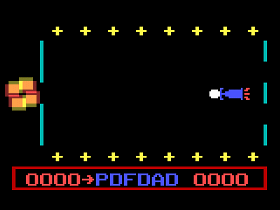 The Game: This is a tale of a futuristic society advanced almost beyond belief. A black hole has been trapped behind a force field, where its gravity won’t snag the chains of space outposts lining the top and bottom of the screen. That gravity will, however, attract stray asteroids, which naturally can do a number on the space stations. This is where you come in: as the captain of an interplanetary street-sweeper, it’s your job to grab the asteroids and deposit them in the maw of the black hole. It’s tricky, business: letting go of an asteroid too far away from the black hole will allow it to drift toward the space stations, but putting your own ship too close to the black hole will put you in harm’s way (and may still let the asteroid escape). The more asteroids you put in the black hole, the bigger and more powerful it becomes (did anyone really think through this method of disposing of the trash?), which will attract more asteroids and cause them to move faster. You can also shoot asteroids, but this will add no points to your score, and stray missiles could destroy space stations. If your ship plummets into the event horizon, or too many space stations are destroyed, there’s suddenly a vacancy for the most dangerous garbage disposal job in the universe. (GST Video, 1984)
The Game: This is a tale of a futuristic society advanced almost beyond belief. A black hole has been trapped behind a force field, where its gravity won’t snag the chains of space outposts lining the top and bottom of the screen. That gravity will, however, attract stray asteroids, which naturally can do a number on the space stations. This is where you come in: as the captain of an interplanetary street-sweeper, it’s your job to grab the asteroids and deposit them in the maw of the black hole. It’s tricky, business: letting go of an asteroid too far away from the black hole will allow it to drift toward the space stations, but putting your own ship too close to the black hole will put you in harm’s way (and may still let the asteroid escape). The more asteroids you put in the black hole, the bigger and more powerful it becomes (did anyone really think through this method of disposing of the trash?), which will attract more asteroids and cause them to move faster. You can also shoot asteroids, but this will add no points to your score, and stray missiles could destroy space stations. If your ship plummets into the event horizon, or too many space stations are destroyed, there’s suddenly a vacancy for the most dangerous garbage disposal job in the universe. (GST Video, 1984)
Memories: As a rule, I try not to be too critical of a game’s programmer, but this rare title – initially released only in South America, and then later dressed up with a spacey background and released in Europe for the Videopac G7400+ under the incorrectly-translated name Neutron Star – offers so little reward for so much effort that one can only assume its designer was a masochist.
Beamrider
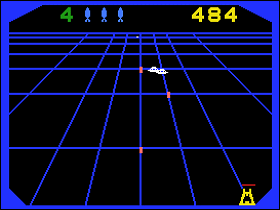 The Game: Alien ships are sliding toward you on a gridwork of energy; as the pilot of the Beamrider, your job is to destroy them before they get too close to home (i.e. the bottom of the screen). They can fire back, though, and while in some cases you can return fire and intercept their shots, it depends on what kind of weaponry they’re using. When you run out of Beamriders, the aliens take over. (Activision, 1984)
The Game: Alien ships are sliding toward you on a gridwork of energy; as the pilot of the Beamrider, your job is to destroy them before they get too close to home (i.e. the bottom of the screen). They can fire back, though, and while in some cases you can return fire and intercept their shots, it depends on what kind of weaponry they’re using. When you run out of Beamriders, the aliens take over. (Activision, 1984)
Memories: The Colecovision port of Activision‘s answer to Tempest, Beamrider is – perhaps not surprisingly – a lot smoother than it is on the Atari 2600. But somehow it manages to take its sweet time getting faster.
Beamrider
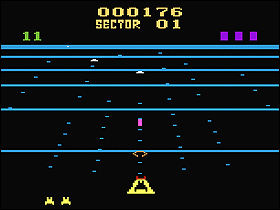
 The Game: Alien ships are sliding toward you on a gridwork of energy; as the pilot of the Beamrider, your job is to destroy them before they get too close to home (i.e. the bottom of the screen). They can fire back, though, and while in some cases you can return fire and intercept their shots, it depends on what kind of weaponry they’re using. When you run out of Beamriders, the aliens take over. (Activision, 1984)
The Game: Alien ships are sliding toward you on a gridwork of energy; as the pilot of the Beamrider, your job is to destroy them before they get too close to home (i.e. the bottom of the screen). They can fire back, though, and while in some cases you can return fire and intercept their shots, it depends on what kind of weaponry they’re using. When you run out of Beamriders, the aliens take over. (Activision, 1984)
Memories: With the abandoned 2600 prototype of Tempest being the closest thing to an exception, Beamrider was the only attempt to the bring that arcade game’s style of action to the 2600. And in the end, Beamrider more closely resembles the one-line idea that led to Tempest: “First Person Space Invaders“.
Ballblazer
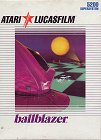 The Game: Pong just got a lot more difficult. The table-tennis-inspired sport is now played at blow-your-hair-back speeds on a 3-D field, with vehicles called rotofoils serving as the paddles. Up to four players can compete, or you can humiliate yourself by trying to fight computer-controlled opponents. (Atari/Lucasfilm Games, 1984)
The Game: Pong just got a lot more difficult. The table-tennis-inspired sport is now played at blow-your-hair-back speeds on a 3-D field, with vehicles called rotofoils serving as the paddles. Up to four players can compete, or you can humiliate yourself by trying to fight computer-controlled opponents. (Atari/Lucasfilm Games, 1984)
Memories: The announcement was simple, and ominous, and got a lot of press. “Lucasfilm is entering the video game industry.” It made big waves, and why wouldn’t it? The thought of someone with the tremendous creative resources of George Lucas getting in on the action was enough to excite many gamers – particularly those who, around 1984, were deluged in the kind of mediocre titles which brought the video game business to its knees.
Vulgus
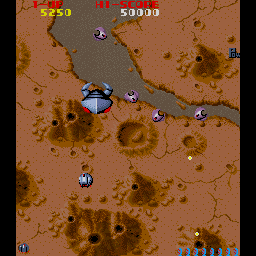
 The Game: Piloting a lone space fighter, you carve a leisurely path through an endless onslaught of alien marauders, none of whom seem to be in any particular hurry to go anywhere either. Despite all this lack of hustle and bustle, however, it must be noted that they’re still shooting at you, and you still need to shoot back, using lasers or a limited supply of missiles. Some aliens will line up in a vertical formation that, if taken out with a missile, means big points, though you should also be saving some of your heavy ammo for larger alien ships that, if lasers were used, would require several shots to kill. (Capcom, 1984)
The Game: Piloting a lone space fighter, you carve a leisurely path through an endless onslaught of alien marauders, none of whom seem to be in any particular hurry to go anywhere either. Despite all this lack of hustle and bustle, however, it must be noted that they’re still shooting at you, and you still need to shoot back, using lasers or a limited supply of missiles. Some aliens will line up in a vertical formation that, if taken out with a missile, means big points, though you should also be saving some of your heavy ammo for larger alien ships that, if lasers were used, would require several shots to kill. (Capcom, 1984)
Memories: Another of Capcom’s long line of vertical-scrolling shooters – a design craze that can be traced back to Namco’s Xevious – Vulgus may seem like it’s terribly leisurely, but it’s actually one of the most grueling hand-eye coordination challenges since Robotron.
Tube Panic
 The Game: You pilot a high-speed starfighter through both open space and narrowly-confined tubes bristling with obstacles and enemies, ranging from scarab-like tanks complete with pincers to tumbling, TIE-fighter-esque ships. Your job is simple: shoot everything, and don’t collide with anything. Periodically, if you survive long enough, you’ll get to dock with your mothership between stages and refuel, and then you plunge back into battle until all of your ships are lost. (Nichibutsu/Fujitek, 1984)
The Game: You pilot a high-speed starfighter through both open space and narrowly-confined tubes bristling with obstacles and enemies, ranging from scarab-like tanks complete with pincers to tumbling, TIE-fighter-esque ships. Your job is simple: shoot everything, and don’t collide with anything. Periodically, if you survive long enough, you’ll get to dock with your mothership between stages and refuel, and then you plunge back into battle until all of your ships are lost. (Nichibutsu/Fujitek, 1984)
Memories: If you’re docking with a mothership, it’s gotta be Nichibutsu’s game (see also: Moon Cresta). An interesting and eminently playable coin-op from the makers of Crazy Climber, Tube Panic is a bit of a cousin of Tempest. In fact, Tempest designer Dave Theurer has said that originally, the knob in Tempest rotated the geometric playing field and not the player’s cannon. Tube Panic goes back to the “rotating playing field” concept a bit and, yeah, one can see where Atari might have wound up with some play-testers with motion sickness back in the day. But Tube Panic is its own game, and it’s a lot of fun.
Time Pilot ’84
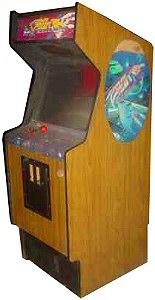 The Game: You’re back in the hotseat as the Time Pilot, but this time an even more fearsome breed of ships from the future is after you. The good news is that you have a new weapon at your disposal – guided missiles – but the bad news is that the enemy has them too. Blast enough enemy planes out of the sky and lure their command ship out of hiding; if you can survive long enough to blow the missile-spewing command ship to pieces, you’re off to the next level. (Konami, 1984)
The Game: You’re back in the hotseat as the Time Pilot, but this time an even more fearsome breed of ships from the future is after you. The good news is that you have a new weapon at your disposal – guided missiles – but the bad news is that the enemy has them too. Blast enough enemy planes out of the sky and lure their command ship out of hiding; if you can survive long enough to blow the missile-spewing command ship to pieces, you’re off to the next level. (Konami, 1984)
Memories: Bearing the deliciously Engrish-esque subtitle “Further into unknown world,” Time Pilot ’84 is a re-interpretation of the original game, with a few more bells and whistles in both the audiovisual and game play departments. Those accustomed to just constantly blasting away with both barrels in the original Time Pilot have to adjust to the proper use of the missile guidance system (don’t waste a missile until your screen paints a viable target), but other than that, it’s the same game with a new coat of paint.
Timber
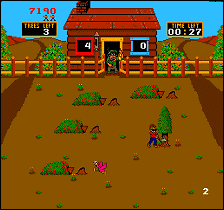 The Game: You’re a lumberjack and you’re okay. Your job is to chop down every tree that grows on the screen, without letting the trees fall on you. Birds are sometime dislodged from their nests as you chop down the trees, and they can be collected for additional points. Bears show up and throw beehives at you, which a lucky swing of the axe can destroy before they do any harm, but it’s altogether more likely that, unless dodged, a beehive will knock your lumberjack over and release a swarm of bees with their own sting operation in mind. You advance to the next level by clearing all of the trees in the time alotted; doing so with time to spare earns a bonus from the big boss; occasional bonus screens challenge you to keep your lumberjack from falling off a rolling log. (Midway, 1984)
The Game: You’re a lumberjack and you’re okay. Your job is to chop down every tree that grows on the screen, without letting the trees fall on you. Birds are sometime dislodged from their nests as you chop down the trees, and they can be collected for additional points. Bears show up and throw beehives at you, which a lucky swing of the axe can destroy before they do any harm, but it’s altogether more likely that, unless dodged, a beehive will knock your lumberjack over and release a swarm of bees with their own sting operation in mind. You advance to the next level by clearing all of the trees in the time alotted; doing so with time to spare earns a bonus from the big boss; occasional bonus screens challenge you to keep your lumberjack from falling off a rolling log. (Midway, 1984)
Memories: One of those offbeat gems that emerged in the ’80s with Midway’s relatively powerful new MCR (Midway Cart Rack) architecture, Timber is a quirky little game that has the unusual advantage of being nothing like any game that preceded it. (It’s hard to think of another game like it that came afterward, for that matter.)